23d General Hospital Unit History
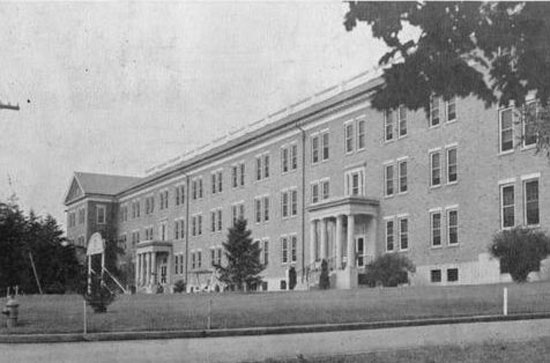
View of 300-man barracks similar to those occupied by the 23d General Hospital during training at Ft. George G. Meade, Baltimore, Maryland (AGF Replacement Center).
Early History & Activation:
As with many of the Hospitals of the WW2 Medical Department, the 23d General Hospital can trace its routes to the World War 1 Base Hospital. Base Hospital No. 23 functioned at Vittel, France taking care of 11,625 patients. The unit was sponsored by the Buffalo General Hospital, which provided the necessary staff and funding to activate such a unit. After the WW1, the unit was deactivated and the personnel returned to civilian occupations.
In December 1940 it was deemed that additional General Hospitals were required to provide sufficient care in a Theater of Operations, and so organization and preliminary training began for Officers and Nurses of a new unit, the 23d General Hospital. This period was spent attending frequent and regular lectures and demonstrations of the required skills for a General Hospital in the field.
Hospital Executive Committees continued preparations in December 1941 and it was proposed that Dr. Baxter Brown be selected as the unit’s Commanding Officer. He was acceptable to the War Department and was given the rank of Lieutenant Colonel.
The 23d General Hospital was officially activated and ordered to Fort George G. Meade, Maryland on 15 July 1942. All of the Officers and about one third of the unit’s Nurses reported for active duty on that date. At the same time, a cadre of 230 Enlisted Men was assigned to the unit from the 209th General Hospital (activated 1 June 1941, supplied Enlisted cadre for affiliated General Hospitals scheduled to embark for overseas between January – July 1942 -ed), which effectively served as a training unit for General Hospital personnel located at Ft. Meade. The period from the unit’s date of activation until the end of 1942 was one of intensive training. At the same time, a recruiting campaign was also conducted for Nurses in the Buffalo area. This was so successful that eventually, the unit had more Nurses than were required by its Table of Organization (T/O & E 8-550). Additional Medical Administrative Corps Officers and two QMC Officers were assigned to duty with the unit, and the enlisted strength was augmented by the arrival of 175 Enlisted Men from Camp Pickett (Virginia) and 99 men from Camp Joseph T. Robinson (Arkansas).
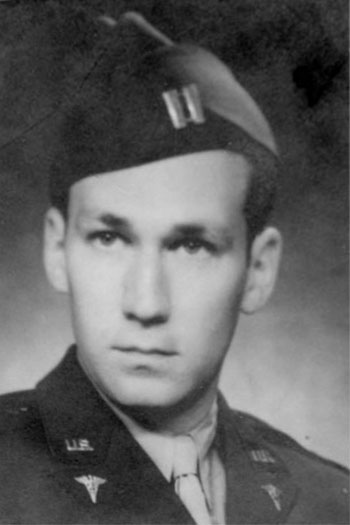
Capt. Allan V. Gibbons worked as a Dentist in the 23d General Hospital from 15 July 1942.
The roster of Medical Officers who left the Buffalo General Hospital as part of the 23d General Hospital was as follows:
| Lt. Col. Baxter Brown | Commanding Officer and Chief of Surgery |
| Lt. Col. Werner J. Rose | Chief of Medicine |
| Maj. Edward G. Eschner | Chief of Radiology |
| Maj. Francis E. Kenny | Chief of Laboratory |
| Maj. Charles T. Kennedy | Chief of Dentistry |
| Maj. Meyer H. Riwchun | Chief of Ophthalmology |
| Maj. Robert C. McDowell | Executive Officer |
| Maj. Frank C. Meyers | Medical Officer |
| Maj. Stephen A. Graczyk | Medical Officer |
| Maj. Irving Hyman | Medical Officer |
| Maj. Harry M. Murphy | Medical Officer |
| Maj. Victor L. Cohen | Medical Officer |
| Maj. Henry J. Brock | Medical Officer |
| Maj. Charles G. Eustace | Medical Officer |
| Maj. Walter S. Walls | Surgeon |
| Maj. Joseph D. Godfrey | Chief of Orthopedics |
| Maj. Martin L. Gerstner | Chief of Otolaryngology |
| Maj. Benjamin E. Obletz | Orthopedist and Registrar |
| Maj. Roswell K. Brown | Surgeon |
| Capt. Vrooman S. Higby | Medical Officer |
| Capt. George M. Masotti | Medical Officer |
| Capt. David H. Clement | Medical Officer |
| Capt. William Manley | Medical Officer |
| Capt. Murray S. Howland | Medical Officer |
| Capt. L. M. Musselman | Medical Officer |
| Capt. George Anderson | Pathologist |
| Capt. Elmer Milch | Surgeon |
| Capt. Rodger Thompson | Ophthalmologist |
| Capt. Robert Boyle | Otolaryngolist |
| Capt. William F. Beswick | Neuro-surgeon |
| Capt. Theodore Jacobs | Surgeon |
| Capt. George H. Marcy | Orthopedist |
| Capt. Russell Erickson | Orthopedist |
| Capt. Hubbard Meyers | Anesthetist |
| Capt. Charles W. Pankow | Dentist |
| Capt. Alan H. Abbott | Dentist |
| Capt. Kermit Allen | Dentist |
| 1st Lt. Warren R. Montgomery | Medical Officer |
| 1st Lt. Henry H. Work | Medical Officer |
| 1st Lt. Bernard M. Norcross | Medical Officer |
| 1st Lt. George C. Brady | Medical Officer |
| 1st Lt. David G. Greene | Medical Officer |
| 1st Lt. Robert M. Miskiman | Medical Officer |
| 1st Lt. Glenn H. Leak | Surgeon |
| 1st Lt. Robert Stein | Surgeon |
| 1st Lt. C. Henry Severson | Surgeon |
| 1st Lt. George W. Northrup | Dentist |
| 1st Lt. Raymond Monin | Dentist |
| 1st Lt. Allan V. Gibbons | Dentist |
| 1st Lt. Mario Gian Franceschi | Radiologist |
| 1st Lt. A. Waite Bohne | Urologist |
| 1st Lt. Millard C. Monnen | Adjutant |
| 1st Lt. James S. Kime | Surgeon |
| 2d Lt. Malcolm Wallace | Medical Administrative Corps |
| 2d Lt. Fred E. Liebig | Medical Administrative Corps |
| 2d Lt. John E. Paplow | Medical Administrative Corps |
Training:
Training of the unit was established on a ration basis, with monthly rotation of some personnel from training status at the Ft. Meade Station Hospital to other kinds of training elsewhere, and vice-versa. Thus, the whole of the personnel was receiving training of a broad and diversified type. Training ‘elsewhere’ meant military training, basic and advanced field training as well as training at Specialist Schools offering courses of many kinds, including advanced University training for many of the professional staff, and temporary duty in several large Army Hospitals for purposes of orientation.
Physical training was given great emphasis and there were teams of many kinds, the unit holding many high places in local sports leagues. On 1 December 1942, the unit won the Touch Football Championship of Ft. George G. Meade after defeating all of the strong local teams including those of the 76th Infantry Division and finally that of the S.O.S Task Force (later the Western Task Force –ed).
One tragic episode took place during the one year stay at Ft. Meade. Maj. Charles Kennedy (Chief of Dentistry) committed suicide by hanging from the rafters in a barracks room. This had a very depressing effect on the entire unit. Col. Werner Rose was appointed to accompany the body home and convey condolences to the family. Capt. Kermit Allen was then appointed as Chief of Dentistry and promoted to Major.
Leave was granted every 2 months for 2 days only. As many of the men as could would leave camp on Friday evening to catch the train out of Odenton or Baltimore for Buffalo. The train cars were often crowded and the men had to stand all the way to Buffalo which meant all night!
The training program continued at Ft. Meade until 18 July 1943. By that date, the unit was up to full strength, splendidly trained, well oriented, enthusiastic and thoroughly ready for service in an overseas destination. During the year, additional changes in personnel were observed. Majors Brown, Riwchun and Cohen were separated from the unit to take up other duties. Lieutenants Monin and Northrup were transferred to the 8th Evacuation Hospital which preceded the 23d to North Africa.
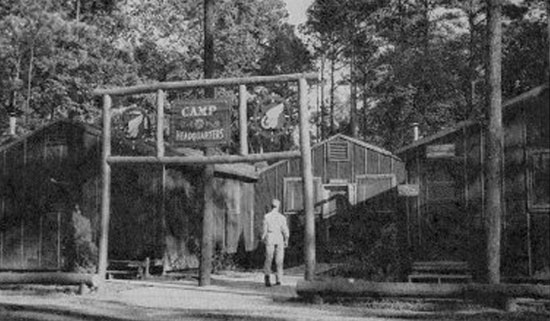
Entrance to the Camp Headquarters at Cp. Patrick Henry, Oriana, Virginia (Staging Area for Hampton Roads P/E), which was home to the 23d General Hospital from 19 July 1943.
Orders had already been received on 16 July for the departure of Ft. Meade. Strict security was to be maintained and all windows on the train were to be closed and the shades drawn. The unit departed Ft. Meade on 18 July 1943 and arrived at Camp Patrick Henry on the morning of 19 July at 0605 hours.
Preparation for Overseas Movement:
The time spent at Cp. Patrick Henry was used in readiness for an overseas voyage. Khaki uniforms were traded in for fatigues, and all personnel received inoculations for any disease that might be contracted outside the US. On 28 July 1943 the unit was notified that it was to leave the following day.
On schedule the next day, the unit was moved at 1645 hours by train to Pier 6, Hampton Roads Port of Embarkation, Newport News, Virginia. The British Royal Navy transport “Empress of Scotland” (formerly the luxury liner “Empress of Japan” –ed.) was boarded immediately after detraining. The ship was completely loaded and departed the ZI on 30 July 1943 carrying a total of 8,000 troops. For the vast majority aboard, it was ‘destination unknown’.
The crossing was largely uneventful and was carried out in a timely manner thanks to the speed of the liner. The last edition of the “Tattle” was published on 3 August 1943. The “Tattle” was the organization’s weekly newspaper which had been published since 27 November 1942, and the special ‘Ocean Edition’ was the 26th number published.
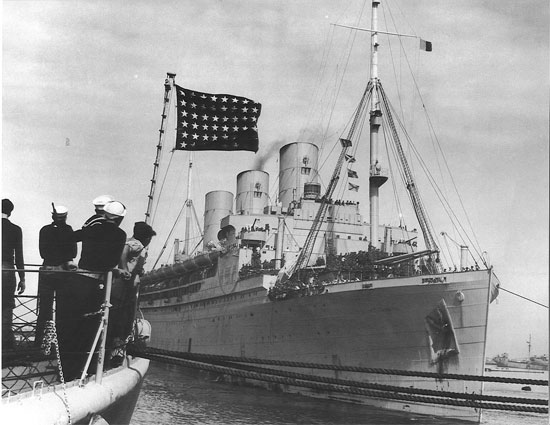
The Royal Navy’s troopship “Empress of Scotland” loaded with troops departs the United States. Photograph taken 30 July 1943.
North Africa:
The ship arrived after dark at Casablanca, French Morocco on 6 August 1943. The unit’s personnel disembarked and boarded awaiting trucks which took them to Camp Don B. Passage, located on the outskirts of the city. Flashlights were prohibited by regulations on board the ship, and were thus stored with TAT (To Accompany Troops –ed.) equipment, bedding rolls and barracks bags. Shelter tents had to be pitched in the dark for the entire Detachment, including mosquito nets. Working thus handicapped it was not possible to get the men to sleep until the early hours of the following morning.
Sometime later, pyramidal tents were pitched which were welcomed by some, but not all. The ground served as a bed, the bedroll for a mattress, and the garrison cap as a pillow. Shortly thereafter, the 33d General Hospital which was tented across Company street moved out. The unit was gracious in giving its furniture to the 23d which made life generally much more comfortable. Items donated to the unit included canvas cots and mosquito net frames, as well as plank flooring for the tents and boxes which could be upturned and used as tables for cards or meals. While electricity was available across the Company street, it was not permitted to the 23d. However, ingenious Gus Gian was able to construct a connection beneath the road and secured electricity in his tent, much to the astonishment of Col. John G. Knauer. Pathways between the rows of tents were given such names as ‘Rue du Camel’ and ‘Place Latrine’.ce Latrine’.
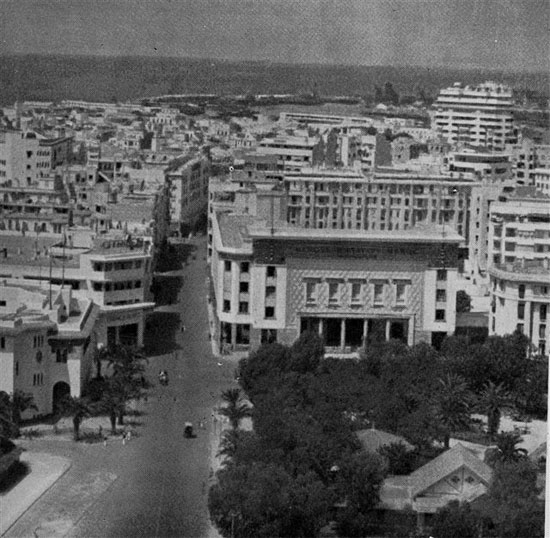
Partial aerial view of downtown Casablanca, French Morocco. Picture taken in November 1943.
News was received of the arrival at Oran, Algeria of the ship carrying the hospital equipment. Two advance parties consisting of 5 Officers and 75 Enlisted Men were sent to the port to take care of the equipment. The detachment travelled to Oran by motor truck and camped at Assi-Ben-Okba where it awaited the arrival of the main body of equipment. Everything was unloaded from the shop on to the wharf and any necessary maintenance was carried out. Although no property was lost, attempts to make away with some of it were frequent and as a result a permanent guard was assigned to watch over it throughout.
Orders arrived late in August for the unit to proceed to Bizerte, Tunisia. The date of departure ordered was 16 September 1943. The Executive Officer of the unit was sent immediately to the new location by plane to select an appropriate site and to arrange for the arrival of the equipment which was to be sent via rail. On 2 September, additional orders arrived requiring 16 Medical Officers to leave the staging area immediately and to proceed by plane to Bizerte for temporary duty with the US Navy. By this time, the unit was in full preparation for the long journey by rail to Bizerte, but within a few days amended orders were received so that the unit was now required to proceed, on the same date originally planned, to Oran, Algeria. Under these amended orders, the unit was assigned to the Fifth United States Army for duty under the temporary operational control of Mediterranean Base Section.
Several days before departure, under the command of 1st Lt. Allan Gibbons, the “40 and 8s” which were to transport the unit were steam cleaned to remove all evidence of any previous animal occupants. Bug bombs were placed in the coaches and after several applications most of the bugs had been removed from the upholstery. The thorough cleaning attempts made the long journey more comfortable and sanitary. While the journey was more rapid than had been expected, it remained largely uneventful. Upon arrival at the destination station in Oran, the unit was immediately moved to Staging Area # 1 (colloquially known to the armies of Africa and Italy as “Goat Hill” –ed.), located at Assi-Ben-Okba. The advance party had already made good preparations for the cadre’s arrival – quarters were ready for the entire unit, apart from the Nurses. The latter were moved to a separate Staging Area at the seaside resort of Aïn-et-Turk.

View of a field hospital in North Africa, 1943. Note the two Lyster Bags suspended from a wooden frame in the foreground.
On 17 September 1943, Maj. Robert McDowell arrived at “Goat Hill” and assumed command of the unit in the absence of Col. John G. Knauer (Commanding Officer). No word had been received from the 16 Officers on temporary duty with the US Navy, and the full story was not learned by the unit until the early days of November.
Since there were no medical duties to be performed in this new location, the vast majority of the personnel was hard at work preparing and augmenting the Hospital’s equipment for shipment elsewhere (presumably Italy). During the early part of October, the unit itself loaded the equipment on the “U.S.S. Robert Stockton”. With a large advance party from the unit on board, this ship sailed from Arzew, Algeria on 10 October 1943.
Orders were received on 16 October to place a small operations detail from the unit on board the “U.S.S. Frederick Funston”, a former Army Transport then in port at Mers-El-Kébir. At the same time, the unit’s Commanding Officer was appointed Commander of Troops aboard the ship and was ordered to draw up plans for the assignment of space to troops of the various units about to embark, their messing, work and guard details. The balance of the unit was to embark two days later, but this order was cancelled and embarkation of the main body did not occur until 23 October 1943. The Nurses embarked on a separate ship, the “Orontes”, which was to leave in the same convoy. The convoy consisted of a total of 9 transports and 7 destroyers.
Italy:
The convoy finally sailed on 25 October 1943 and arrived in the harbor of Naples, Italy 3 days later after a quiet and smooth voyage across the Mediterranean Sea. Meanwhile, the advance party had proceeded on the “Robert Stockton” only as far as Oran, and was in a different convoy which did not leave Oran until after the main body had sailed. As a result, it did not reach Italy until 10 November 1943 – two weeks after the arrival of the unit.
The unit landed at Bagnoli, a small sub-port of Naples. The beach had been mined by the enemy and it was the misfortune of the unit to have 28 of its personnel wounded by the explosion of one of these mines just moments after they had waded ashore. Five of these personnel were severely wounded, and Pfc. Frederick W. Ricks died of his wounds in a hospital located in the Mostra area the same day. Several others were permanently injured and had to be returned, later, to the Zone of Interior by Hospital Ship.
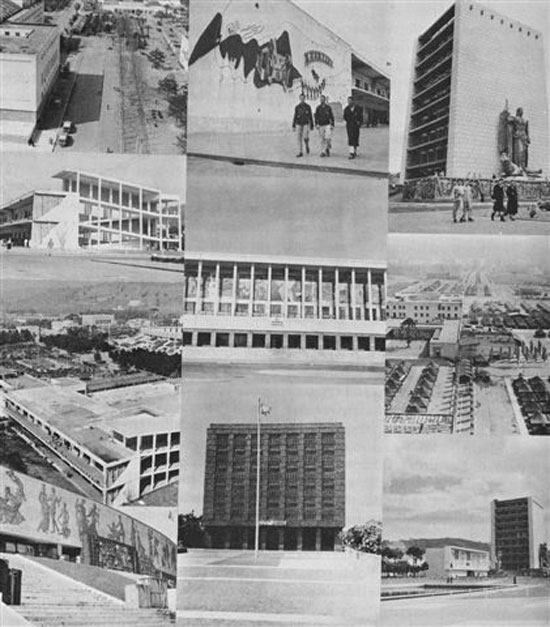
Different views of the Mostra Fair grounds, home of the Naples “Medical Center”.
Personnel from the unit marched from the beach to a temporary staging area located just outside the Mostra Fair grounds. The personnel were quartered in three buildings all of which had been damaged by bombing. Many walls were destroyed, the roof had collapsed and in portions of the buildings all windows had been blasted out. It was soon found that a great Medical Center had been planned for the Fair grounds, and that three of the buildings had been reserved for the 23d General Hospital. An air raid by the enemy several days before had demolished or rendered inhabitable several other buildings which the Hospital was to have had.
The period until 15 November was utilized by the organization in obtaining material from the wrecked buildings with which to help patch up the less badly damaged buildings which it was to occupy. Soon, Italian stonemasons were employed by the unit to do some of this work, as the small details of Engineers could not realistically carry out all of it. Due to problems with the unit’s equipment, there were no transports available. However, some small Italian wheel-barrows were found and much material was transported by making use of them.
On 15 November it was possible to unload the “Robert Stockton” and trucks backed into the harbor and were loaded directly from the ship by means of nets. Due to the damage sustained on the pier, there was only space to unload one ship at a time. The men of the unit on the hop and on the trucks handled every piece unloaded, and the work was completed within 36 hours, ending at 2230 hours on 16 November 1943.
The unit received its first casualties on 17 November 1943 and was officially opened as a General Hospital (the 23d General would operate at the Mostra Fair grounds from 17 November 1943 until 26 September 1944 -ed). A total of 339 patients were received, the vast majority being combat patients from the surrounding areas. Reception of hundreds of patients continued until the end of the year, as too did the restoration of buildings by the unit and the Engineers. By midnight on 31 December 1943, the Hospital had received a total of 2,332 wounded, although its doors had been open for only 45 days. The surgery was slow in getting started because the building required more reconditioning than the others which were used as wards, and the installation of generators and cyclotherms was delayed due to lack of replacements for missing or broken parts. Two minor operations were performed in November, and the first laparotomy was carried out on 3 December. A total of 238 operations of all kinds were performed during November and December.
The new year saw a total of 1,297 patients in the Hospital. A sudden and severe tempest of wind caused a heavy masonry wall to blow down in the unit’s motor pool, capsized tent wards # 60, 61 and 62, bent or blew over scores of trees and uprooted and blew away much shrubbery. The new year started with a flurry of action and it continued so. Two prefabricated huts had been erected in December and 20 more were added throughout January, thus providing indoor shelter for many additional patients. On 22 January 1944, the Anzio Bridgehead was established and 11 patients were received from the invasion force the same night. From this time on until the junction of the Bridgehead forces with the main forces occurred on 25 May, the Hospital continued to constantly receive patients both from the Anzio Bridgehead and from the troops operating south of Monte Cassino. By the end of January the Hospital had a total of 57 wards in buildings, prefabricated huts or tents, with beds or cots for 1,846 patients. 312 operations were performed and 135 casts applied through the month, and a total of 2,622 patients had been admitted.
Throughout February, it was very difficult for the Hospital staff to keep ahead in the matter of vacant beds. Between 2 February and 5 February inclusive, 1,129 patients were admitted and 445 patients were discharged to duty or evacuated by air to North Africa. On 9 February another storm struck the Hospital area. This time several large sections of the walls of the nine story tower building were blown in, while six sections were blown off the roof of prefabricated hut ward # 75. The tower building was full of patients at the time, and two of these received slight injuries due to the caving in of sections near their beds. The Hospital was kept extremely busy during this period, and at the same time many key personnel were sick.
A number of distinguished visitors came to the Hospital through February – these included Major Generals McNair, Robertson and Hurd, as well as Colonel Holst; Surgeon General of the Norwegian Army. A total of 515 surgical procedures were performed and 151 casts applied. The Hospital admitted a large number of patients, and by 5 February had 2,165 patients with remaining space for a further 45 patients. This was the maximum number of patients cared for by the staff in any one day since the Hospital opened its doors. The volume of work is best illustrated by the fact that 54,320 patient days were spent in the Hospital during this month, and the daily average number of patients in hospital was 1,873. The Hospital now had 65 wards in the buildings, prefabricated huts or tents. Space for new patients was only made available from day to day by the most careful attention to the matter of getting patients to duty as soon as possible; 1,851 patients were discharged from the Hospital during the month. Of these, 126 were evacuated by air and 134 by ship to North Africa, and with a few exceptions the remaining patients were returned to duty status.
March 1944 saw an influx of severely wounded patients, and although only 812 admissions and 783 discharges were carried out, the staff was as busy as in the previous month. 6 March 1944 saw the beginning of a hepatitis and jaundice research program instituted by Colonels Barker and Cornell which was to cover many months and include thousands of cases in the study. The patients were hospitalized in the Hospitals of the Medical Center, with the 23d General Hospital having the greatest number of cases (843). On 12 March, the Education and Rehabilitation program for patients started with a Company of convalescent patients of the Hospital under the instruction of Lt. Donald E. Montgomery (Infantry). This program was to continue until the Hospital Plant closed down in Italy. It was to grow and assume considerable importance, and was to provide rehabilitation for thousands of patients.
On 13 March 1944, Major Benjamin C. Lyons, MC visited the Hospital and outlined to its staff his method of treating war wounds by administration of penicillin, repeated blood transfusion and more radical debridement of wounds. The program was initiated on 15 March 1944 in Ward 24 by Capt. Marcey with the able assistance and encouragement of Maj. Lyons. The Hospital’s Blood Bank was started the same day. The program gained momentum until there were four full wards receiving this kind of treatment. This work proved worthwhile however, since the long list of seriously sick patients on the surgical service was reduced to almost nil. In addition, it was discovered that the wounds healed more rapidly and with less danger of infection under this kind of treatment.
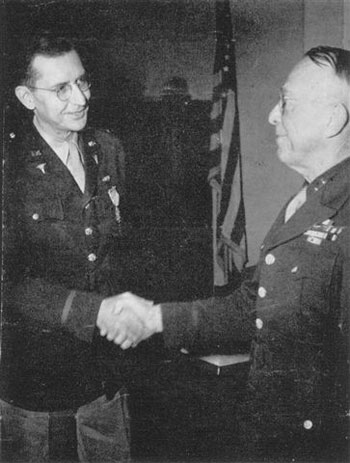
Major B. Champ Lyons, MC, being congratulated by Maj. General M. C. Stayer (Surgeon, NATOUSA), after being awarded the Legion of Merit for his outstanding work on penicillin in the Mediterranean Theater of Operations.
The Lyons-penicillin treatment of wounds continued intensively throughout April, during which period the surgery was not only extremely busy but also thronged with visiting surgeons observing the method of treatment and the results obtained. Most of the 58 cases that had received this treatment since it was initiated in the Hospital on 15 March were still in the Hospital together with the 50 cases treated in April. There were 926 patients admitted and 1,113 patients discharged in April. Of the latter, 380 were evacuated to North Africa by ship and 1 by plane; all but a few of remainder being returned to active duty. The four othopedic wards were a forest of Balkan frames. Patients spent a total of 42,164 patient days in the Hospital during April 1944.
During the 5 ½ month period from 17 November 1943 to 30 April 1944, the Hospital had admitted 10,857 patients who spent a total of 224,912 patient days in complex. Starting with only one building with a total bed capacity of 500, the wards had increased to 74, located in 54 buildings, prefabricated huts or tents with a total bed capacity of 2,300. As many as 541 patients had been admitted in any day (3 February 1944) and as many as 2,071 patients had been cared for in the Hospital in any one day (5 February 1944). 1,618 surgical operations had been performed, and 763 casts had been applied.
Throughout the month of May, patient flow and census remained around the same as the previous few months. However, this time the Hospital’s staff was more experienced in dealing with the cases and better versed with the Lyons-penicillin method of treatment. Just as in the previous months, the Hospital carried a load of 2,022 patients with no increase in personnel whatsoever. Despite the fact that on paper the Hospital’s strength remained the same, there was a serious decrease for large numbers of Officers, Nurses and Enlisted Men were sick throughout the month.
Of special interest to members of the 23d General Hospital was the fact that on 17 May 1944, the unit had been performing its full mission as a functioning General Hospital in the Theater of Operations for six months. During this period, it had cared for 11,681 patients. To celebrate the event two parties were held – the first parties to be held by the unit since its arrival overseas on 6 August 1943. An Officers’ and Nurses’ party and dance was held in the Officers’ Mess on the same night, and the Enlisted Men’s party and dance was held in the area NCO Club on 25 May. The attendance was large and both parties and dances contributed measurably to the morale of the staff.
The surgical service had just cause for rejoicing when on 16 May hot water boilers and tanks were installed. They were connected with pipes which had already been in the building when it was first occupied in November 1943. The patients received their full share of benefit from the provision of running hot water, not only in the form of better bed baths for the bed cases, but also in the form of showers, and of water for washing and shaving for the others.
The 23d Gen Hosp also sent a surgical team to the front for emergency service during the offensive. The team consisted of: Maj. Burke (MC), 1st Lt. Stein (MC), 2d Lts. Cavagnaro and McPeack (ANC), T/4 Elliott and Pfc. Swanson. They operated with the 93d Evacuation Hospital from 14 May to 19 May 1944.
On 20 May 1944 at a meeting held in the office of Col. Richard T. Arnest (Surgeon, PBS [Peninsular Base Section –ed.]) in Naples, it was announced that the 23d General Hospital was to be expanded from a 1,000-bed Hospital to a 2,000-bed Hospital with additional expansion allowance of 50%. Tentative new T/O and T/E were furnished. Announcement was made that the 53d Station Hospital was to be inactivated and its personnel largely to be absorbed by the 23d, together with much of its equipment as might be needed to operate the enlarged General Hospital (this large reorganization which took place in June 1944 involved a number of General Hospitals. The 21st General Hospital absorbed the 58th Station Hospital including operation of the Pomigliano Airfield Holding Hospital; the 23d General Hospital absorbed the 53d Station Hospital also taking over the VD Hospital and the disciplinary wards; the 36th General Hospital absorbed the 43d Station Hospital; and the 300th General Hospital took over personnel and equipment of the 66th Station Hospital and continued to operate the PW Hospital at Dugenta -ed).
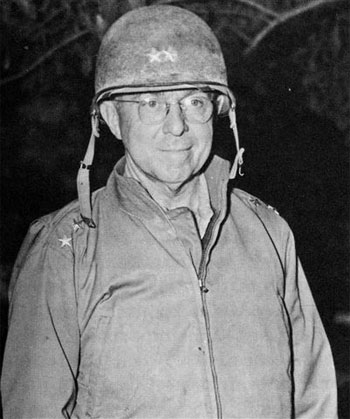
Picture of Maj. General Morrison C. Stayer, Surgeon, NATOUSA (succeeded Maj. General Frederick A. Blesse, 1 March 1944). On 1 November 1944, Theater boundaries were redrawn, excluding Southern France, and NATOUSA was redesignated MTOUSA. Maj. General M. C. Stayer remained Theater Surgeon and Lt. Colonel Earle Standlee became his Deputy.
The Hospital was visited and inspected by Major General M. C. Stayer (Surgeon, NATOUSA) on 21 May. On 30 May, Memorial Day ceremonies were held in the Medical Center Music Hall. The ceremonies were attended by the Commanding Officers of all the PBS General Hospitals, as well as by patients and personnel. The speaker was Maj. Gen. A. R. Wilson, Commanding General PBS.
Although the patient population of the Hospital had increased in May from 1,313 to 2,022, the organization had to continue expanding until there were more than 3,200 beds and nearly 3,000 patients. For the month of June 1944, a total of 4,182 patients were admitted, and the daily average number of patients was 2,611 with a maximum of 2,951 on 9 June. This represented the greatest load in professional and administrative work ever encountered by the Hospital thus far.
A tentative T/O and T/E arrived and the 23d General Hospital was officially organised as a 2,000-bed General Hospital, effective 5 June 1944, pursuant to the provisions of Sect. II, General Orders No. 105, Headquarters, Peninsular Base Section, APO 782 dated 3 June 1944. Reorganization was initiated on the same day and the unit received additional personnel from four Station Hospitals which were being inactivated at the same time. The grounds and installations of the newly inactivated 53d Station Hospital were also taken over for use by the unit. It is noteworthy that the reorganization occurred during the busiest month the 23d had experienced. For example, during the month of June, 79,143 patient days were spent in the Hospital by its patients. Along with the activity of the Hospital, the work of the American Red Cross unit increased to such an extent that it was necessary to assign three additional Red Cross workers during the month.
Under the energetic and enthusiastic leadership of Lt. Jerbi, the Education and Rehabilitation Unit was amplified and improved greatly during June 1944. Additional space was provided in the new Area C (formerly occupied by the 53d Station Hospital), offices, supply, mess facilities and a day room were provided, and tentage for additional patients was set up. By 19 June there were 216 trainees, and during the month hundreds of convalescent patients received the benefit of this program before returning to duty. In addition, a three-day course of training in motor maintenance was given to all of the Administrative Officers of the Hospital by Officers of the Ordnance Department of PBS. The basic principles underlining the need for the various echelon types of motor maintenance were stressed underscoring first and second echelon maintenance.

Partial view of PBS (Peninsular Base Section) medical storage area in Leghorn (Livorno), Italy. Picture taken early 1945.
The Irving Berlin show “This is the Army” played in the Medical Center Music Hall in June to the delight of both patients and personnel. The composer himself visited the wards of the Hospital on 6 June 1944.
The average number of patients in the Hospital per day in July was 2,431. The peak was reached on 8 July with 2,982 patients. Total cases admitted to the Hospital during July 1944 was 4,838. One highlight of July 1944 was the first unit wedding, which was conducted by Chaplain A. Ziober uniting the marriage of Lt. Florence Rowland and Capt. Fred Nelson.
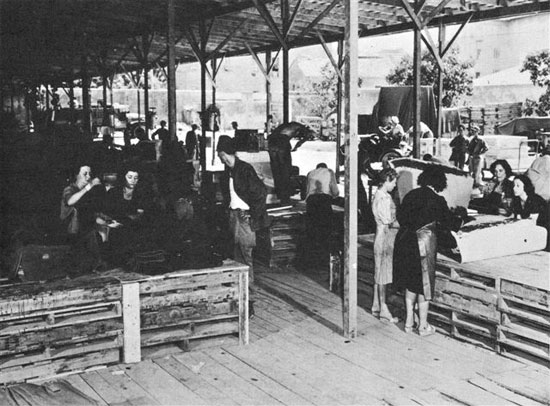
Civilian contracted manpower readying medical supplies for transshipment from PBS to the Southwest Pacific Area (SWPA). During redeployment, all surplus equipment was turned in from Fifth United States Army and PBS units for reconditioning and repacking for reissue. View taken either at the Naples or Leghorn depots.
It should be noted that on 7 August the Hospital sent a shock team to work with the 93d General Hospital on the Seventh United States Army front in southern France. The members of this team were: Capt. Henry H. Work (MC), T/4 John L. Elliot and Pfcs. Jasper M. Huls, Harry Culbertson, Russel Melton and Philip J. Mastrianno. This team remained on this duty throughout the remainder of the month.
Soon after the Invasion of Southern France, the 23d again found itself receiving patients from two fronts, but this time one of the two fronts was in a different country, and the forces there were from a different Army. 517 of the 4,782 patients admitted to the Hospital in August were from Seventh United States Army in Southern France, 250 of them in a single day (18 August). The surgery once again was a busy place. The unit continued to work hard with the influx of patients received, and was finally cleared of all cases on 26 September 1944.
France:
All of the Hospital’s equipment was crated and Officers and Enlisted Men proceeded by various ships to the port of Marseille. Maj. Francis Kelly was put in charge of personnel consisting of Nurses and Enlisted Men and traveled by Hospital Ship to Marseille, arriving on 18 October 1944. Upon arrival, the unit quickly established camp in the hills north of the city. Blankets and any other material (newspaper –Stars and Stripes) were utilized to keep the men warm in their cots. A makeshift stove was made out of a 10 gallon food can. Holes were punched into the lower sides and rocks placed in the bottom of the can. This was then filled with gasoline to stone level and lit. A soft glowing flame in the can resulted and gave considerable warmth to the tent. One tent housed Maj. Steve Graczyk, Anthony Ziober and Frank Kenny.
Again with no medical or other duties to keep the men occupied, there was a general exodus from camp. There were trips to Avignon and Marseille but Aix-en-Provence was the favorite. Most popular here were the services that were offered; a shower in the public baths cost 10 francs (22 cents), a haircut 24 cents and a glass of beer 30 cents.
On 23 October 1944, Maj. Frank Myers was promoted to Lieutenant Colonel and there was an inadvertent routine issue of a liquor ration. A party quickly got under way which became quite raucous, eventually leading to a disturbance of the peace in camp.
With the arrival of the balance of the unit, a furniture moving detail was instituted in order to furnish the barren rooms of the Continental Hotel which was to become the quarters of the Medical Officers and Nurses. Distributions of various choice beds and furnishings were made according to rank. Setting up a Hospital for the second time was easier than the first for the unit’s personnel. Electricity and hot water were available this time around, and the Hospital opened on 5 November 1944. Work again resumed as usual but not with the intensity of that which had been experienced in Naples.
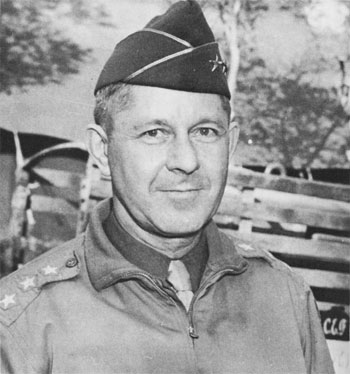
Lieutenant General Jacob L. Devers (CG, Sixth US Army Group) visited the unit during its time in France in December 1944.
On 5 December 1944, a friend of the unit visited from Buffalo. This was Col. Harold Zittel who had served with Base Hospital Number 23 during World War I. The visit was welcomed by all, and prepared the unit for further visits by other important figures that month. These included Generals Devers, McAuliffe, Schram and Gavin.
25 December 1944 – 1 January 1945 was a period of general relaxation. However, during this period, two events took place which dampened the spirits of the group. 1st Lt. Robert Stein underwent surgery and was found to have teratoma of the testes. He was sent home for treatment, and shortly after Maj. Henry Brock became ill and was also returned to the Zone of Interior.
The Hospital again became very active after January 1945 receiving battle casualties from the Battle of the Bulge and the Colmar pocket to the southwest of Vittel. Rumors flew at the time that all Medical Officers were to carry sidearms. The event never materialized, partly because the arms were not available and partly because the Medical Officers would not know how to use them. The same month, Walter Walls was transferred to another Hospital in Lunéville to become the Chief of Surgery.
The winter in Vittel was relatively moderate both as to snowfall and humidity. The Continental Hotel served as excellent quarters, offered good dining facilities, and was within walking distance of the Hospital complex. Never did the temperature approach the zero mark. The Officers were well cared for. The Hospital’s Enlisted personnel occupied the lower floors and the Nurses were quartered above.
Before coming to Vittel, the 1st Fighter Group (USAAF) had acquired a ward in Normandy. During this period, the group had adopted a 16-year old girl whose family had been destroyed and she lost both legs during the fighting. She was brought with the unit to Vittel and the unit CO asked Colonel Werner Rose if he could take her into the 23d General Hospital for continued care. With some stretching of the rules, this was done and the Fighter Group gave $2,300 toward her care. Rose finally arranged for her transfer to a civilian hospital and turned over the Air Force money to take care of her expenses.
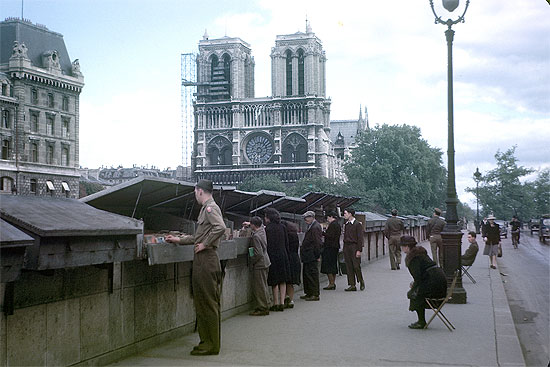
Color photograph showing members of the 23d General Hospital visiting Paris in 1945.
The war continued to progress and eventually moved further away from the site at Vittel. On 7 May 1945, a ceasefire was put into effect. There was much rejoicing among the Hospital’s patients, staff and the local civilian population. With the ceasefire, the purpose of the 23d General Hospital was accomplished and the dispersion of its personnel began. Col. John G. Knauer was transferred to Berlin and Col. Baxter Brown was appointed as the new Commanding Officer. Capt. George Marcey was transferred to the 160th General Hospital in England to become Chief of Orthopedics.
On 17 June 1945, EM Beswick, Anderson, Musselman and Howland were separated from the unit. It was assumed that they would be going to the Pacific Theater of Operations; however, peace in Japan caused their ship to be diverted and they were returned home. A number of other transfers were also carried out at this time, with some Officers and Enlisted Men from the unit being returned to the US for early discharge.
Following V-E Day, 500 German prisoners were assigned to the 23d to help with its maintenance. They were housed in the hotel stables and quickly converted them into suitable living quarters. On 10 July 1945 the unit left Vittel and moved to Paris to occupy l’Hôpital de la Pitié. The character of the patients changed from battle casualties to local accidents and illnesses. The Officers of the 23d were gradually assigned to other units and were replaced by new Officers.
Medical work was almost non-existent and there was much time for sightseeing. The most popular places included the Eiffel Tower, the Louvre Museum, the Beaux Arts School, the Follies and Casino & Suzie Saladass Chanteuse night club. More extensive trips were taken to England, Scotland and other parts of Europe.

Dentist, Capt. Allan V. Gibbons photographed with his family on leave in the Zone of Interior.
Return to ZI:
On 14 September 1945, l’Hôpital de la Pitié was officially closed. The men were dispersed and sent back to the Zone of Interior by plane or ship. Col. Werner J. Rose moved out alone and was appointed as the Commanding Officer of a small detachment that flew across the Atlantic. A larger group left a few days later flying from Paris to Lisbon, to Madeira Island, then to Newfoundland, and finally to Wilmington, Delaware. The final group of Hospital staff were sent to Le Havre and waited for a ship assignment without success. They were then sent to Marseille where they eventually boarded a Liberty Ship in mid-November.
A stormy crossing of the Atlantic Ocean saw all of the unit’s staff returned to the USA, where they were discharged from the Army at Fort Dix, Wrightstown, New Jersey, on the day before Thanksgiving, 1945.
Official Campaign Credits:
The 23d General Hospital received the following campaign credits for its overseas service; Naples-Foggia and Rome-Arno. It arrived in the Mediterranean Theater of Operations 28 October 1943, and was officially transferred to the European Theater of Operations on 20 November 1944.
The authors are indebted to Susan Alford, daughter of Captain Allan V. Gibbons (ASN:O-403030) who served with the 23d General Hospital as a Dentist from 15 July 1942 until 12 December 1946. Susan has kindly provided the MRC with a number of contemporary documents relating to her Father’s unit, as well as some of the illustrations used herein.
